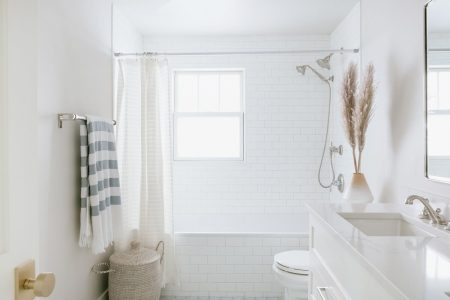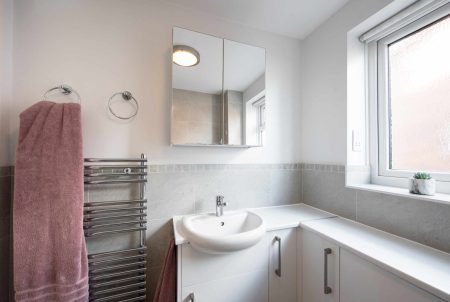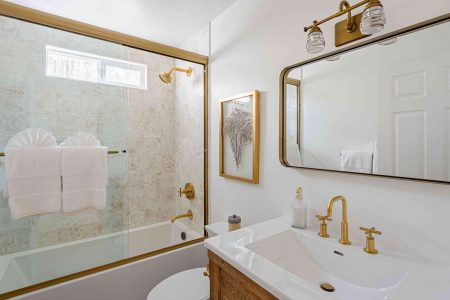There are seemingly endless choices available for bathroom sinks and vanity cabinets. You can spend $50 for an inexpensive wall-hung sink or upward of $5,000 for a furniture-quality cabinet vanity. Some sinks are self-contained; others must be installed in or on a countertop, and some sinks are mounted in a piece of cabinetry. There is no one best style, and the many options exist because of the wide variety of situations presented by bathroom designs.
We’ve reviewed the most common types of bathroom vanities and sinks available, including the following:
- Wall-mounted sink
- Pedestal sink
- Vessel sink and vanity
- Framed sink
- Drop-in sink
- Under-mount sink
- Cabinet-style vanity
-
01
of 07Wall-Mounted Sink
The wall-mounted sink is one of the most basic and common bathroom sinks found, especially in older homes and apartments. It is used most often when available space (or your budget) is tight.
These sinks mount, as the name suggests, directly to the wall with no floor support. They attach to special hanger brackets fastened to the wall and to framing members or a wall reinforcement behind the sink. Plumbing waste and supply lines may either be exposed or concealed in a “shroud” or cover fastened to the underside of the sink. They’re great for smaller bathrooms or to lend a modern flair.
-
02
of 07Pedestal Sink
The pedestal sink is a classic. This floor-mounted sink is commonly found in apartments, older homes, and newer homes. Like the wall-hung sink, it is often used when space is tight, but it is elegant enough to be used as a focal point in the bathroom design when space is not an issue.
As the name suggests, these sinks appear to be mounted atop a pedestal that supports it off the floor. Sometimes, that’s exactly the situation. With other designs, though, the sink is mounted to the wall and essentially hangs here, while the pedestal is purely decorative, used to give the appearance of a classic pedestal sink. With either type, plumbing waste and supply lines are usually concealed in the pedestal.
-
03
of 07Vessel-Sink Vanity
The vessel sink is a fairly new arrival on the bathroom scene and creates a unique vanity. This sink sits atop a countertop that is often fastened to a floor-mounted vanity base, which, like most all vanities, is fastened to the wall for stability. Vessel sinks require a non-standard faucet and waste-drain system and are used in new construction or major bathroom renovations. The faucets for these sinks are either deck mounted on a pedestal or are wall-mounted.
The sink, as the name suggests, is simply a vessel into which a faucet pours water. The vessel becomes an art object of sorts and can range from a porcelain china bowl or granite or alabaster stone or blown art glass. The design options are essentially unlimited, and the nice thing is you can have a very striking and custom-looking piece for a reasonable amount of money. Plumbing waste and supply lines are either concealed in the vanity base or exposed, but, if exposed, they are designed to visible and attractive.
Elaborate designer vanity cabinets are available for these sinks, but some homeowners exercise their creativity by converting antique dressers or side tables into wonderful bases for vessel sinks.
-
04
of 07Framed Sink
The framed sink, sometimes called a rimmed sink, is installed in a vanity countertop. This style sink is commonly found in apartments, older homes, and less expensive newer homes. They are usually installed into plastic laminate countertops.
As the name suggests, these sinks drop into a countertop and are trimmed out with a metal “frame.” The sink itself can consist of cast-iron or porcelain-enamel coating bonded to a cast-iron or pressed-steel core (usually the latter). Plumbing waste and supply lines are concealed in the vanity base.
Continue to 5 of 7 below. -
05
of 07Drop-In Sink
The drop-in sink is often called a self-rimming sink or surface-mounted sink and is typically installed in a vanity countertop. This style sink is very common to older and newer construction and remodels alike. These sinks can be installed into any type of countertop including plastic laminate, stone, ceramic tile, or synthetic composite countertops, such as Corian® or Silestone®.
These sinks have a lip that is over-sized to the hole and simply “drop in” a countertop. Heavy, cast-iron sinks may be simply held in place by their weight, but lighter sinks usually have a clamping system that secures the sink to the countertop from underneath. This creates a self-trimming installation.
-
06
of 07Under-Mount Sink
The under-mount sink is a premium, clean-looking sink found most often in newer construction and remodels. They cannot be installed into plastic laminate or tile countertops. They can only be installed into solid-surface counters such as stone or synthetic composite tops such as Corian® or Silestone®.
As the name suggests, these sinks mount from the underside of the counter. They are slightly larger than the opening of the top so that the countertop creates a slight lip or overhang over the sink bowl. The bathroom sink itself is typically made from porcelain-enameled cast iron, vitreous china, a metal such as copper or stainless steel, or out of a composite resin material. If the sink and the top are composite resin, then the sink can be manufactured integral with the top (like the “cultured marble” tops of old). Plumbing waste and supply lines are concealed in the vanity base.
-
07
of 07Cabinet-Style Vanity
The vanity cabinet that supports most types of bathroom sinks (except for pedestal sinks) can be of many, many different styles. Vanity cabinets can range from very narrow, inexpensive cabinets that hold a small sink to expansive double-wide cabinets that hold a double sink and countertop to very expensive cabinetry that simulates the look of a fine piece of antique furniture. In each case, the cabinet conceals the drain waste pipes and water supply pipes within.
The countertops covering the vanity cabinet and supporting the sink can be of many materials, including plastic laminate, ceramic tile, solid-surface or synthetic stone, or natural granite or quartz.
Read the full article here














